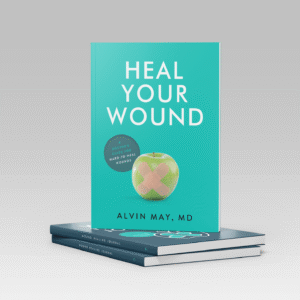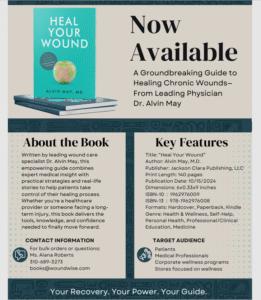Healing Beyond the Surface
Disclaimer: This post contains affiliate links for which I may earn a small commission if you click on them and make a purchase.Healing Beyond the Surface: Why Proper Chronic Wound Care Matters
Guest post by: Dr. Alvin May, Author of Heal Your Wound
Chronic wounds are more than just a medical issue; they can be a daily challenge that can impact every part of a person’s life. From physical discomfort to emotional stress, these wounds often linger for weeks or months, especially when tied to conditions like diabetes, poor circulation, or limited mobility.
But here is the good news: with the right care and tools, healing is possible—and it starts with an understanding of the importance of proper treatment.
The Hidden Burden of Chronic Wounds
Chronic wounds affect millions of people and are often underestimated. They can be
painful, prone to infection, and emotionally exhausting. Without proper care, they can lead to serious complications like infections, amputations, and even increased mortality. That is why early intervention and consistent and informed care are so critical.
What Proper Wound Care Looks Like
Effective wound care is not about changing bandages. It is a structured process that
includes:
● Cleaning and debridement to remove dead tissue
● Infection control to prevent complications
● Moisture balance to support healing
● Monitoring wound edges to track progress
This approach helps healthcare providers tailor treatment to each patient’s unique needs.
But even the best care plans rely on one key factor: communication.
The Emotional Side of Healing
Living with a chronic wound can be isolating and stressful. Physical pain is often
accompanied by emotional strain—frustration, anxiety, and even depression. That is why it is important to support not just the body, but the mind as well.
>Creating space for emotional reflection, whether through conversation, support groups, or personal journaling, can help patients process their experiences and stay mentally strong throughout recovery.
Why It Matters
When patients are engaged in their care, outcomes improve. Tracking symptoms, staying informed, and communicating clearly with healthcare providers can make a significant difference. For home healthcare workers, understanding the patient’s day-to-day experience is key to adjusting care and offering the right support.
In short, proper wound care is more than just treating the wound—it is about supporting the whole person.
Take the First Step
If you or someone you care for is managing a chronic wound, take steps to stay involved and informed. Whether through daily observation, open communication with your care team, or finding ways to reflect and reduce stress, every small action contributes to healing.
For more information on chronic wound care, pick up a copy of Dr. May’s newest book,
“Heal Your Wound.”

Healing the Hidden Wounds
Below by Laurie Harmon at Seeking Serenity and Harmony
The piece by Dr. May stands out to me, as I know from personal experience, the longer you delay getting help for mental health struggles, the bigger effect it will have on your brain and body. So many people avoid treatment due to the stigma. I know I was one of them. Self-care, which is a must, includes focusing on your mental along with physical health.

Healing Hidden Trauma Wounds
Hidden trauma wounds—those emotional scars that are not visible to the eye—can be just as debilitating as physical injuries. They often stem from experiences such as neglect, abuse, loss, or prolonged stress, and they can remain buried for years, influencing our thoughts, emotions, and behaviors without us even realizing it. Just as a chronic physical wound can limit mobility and cause ongoing discomfort, unhealed emotional wounds can quietly erode our sense of self-worth and peace. They often manifest through patterns like self-doubt, avoidance, or difficulty trusting others, creating an invisible weight that affects every aspect of daily life.
When hidden trauma wounds go unaddressed, they can feed into depression and anxiety. The mind may replay old pain in a loop, leaving a person feeling stuck in the past while also fearful of the future. This emotional state can lead to fatigue, irritability, overthinking, and difficulty engaging in activities that once brought joy. Because these wounds are unseen, others may underestimate their impact, which can leave the person feeling misunderstood or even more isolated. Over time, the unhealed pain can drive behaviors like withdrawing from relationships, lashing out in frustration, or turning to unhealthy coping mechanisms.
Breaking the Cycle of Emotional Distress
Healing these hidden wounds is essential for breaking the cycle of emotional distress. Just like physical healing requires rest, care, and sometimes professional treatment, emotional healing calls for intentional practices that nurture the mind and heart. Therapy, support groups, journaling, and mindfulness techniques can help individuals explore their pain in a safe space, release harmful beliefs, and rebuild emotional resilience. The process is rarely quick or linear, but every step toward self-awareness and self-compassion brings relief from the heavy burden that trauma creates.
By prioritizing emotional healing, we not only address the root causes of depression and anxiety but also create the foundation for a more balanced and fulfilling life. When hidden wounds are acknowledged and tended to, a person can begin to see themselves not through the lens of their pain, but through the lens of their strength and growth. This shift allows for healthier relationships, improved coping skills, and a renewed sense of hope. Just as the body thrives when physical wounds are healed, the mind and spirit flourish when emotional wounds are given the attention they deserve.

Healing hidden trauma is more than overcoming the past—it’s reclaiming your peace. We believe every step toward emotional wholeness is a step toward a life with less shame, judgment, and stigma. By tending to the wounds we cannot see, we make space for the serenity and harmony we’ve been longing for all along.”



